#james hardie president's club
Explore tagged Tumblr posts
Photo

Denver Exterior Fiberboard Large transitional gray two-story concrete fiberboard exterior home idea with a shingle roof
#alternating exposure#colorado siding repair#exterior home remodel#sherwin-williams#james hardie president's club
0 notes
Photo

Fiberboard - Craftsman Exterior Example of a large arts and crafts multicolored two-story concrete fiberboard house exterior design
0 notes
Text
Exterior in Denver

Exterior view of a modest two-story tuscan white concrete fiberboard house.
#composite wood to hardie#james hardie president's club#james hardie#colorado siding repair#hardieshingle#duration
0 notes
Photo

Exterior Fiberboard Denver Example of a large arts and crafts multicolored two-story concrete fiberboard house exterior design
#full replacement#james hardie#james hardie president's club#denver homes#james hardie elite preferred#fascia#hardieshingle
0 notes
Photo

Large eclectic beige two-story concrete fiberboard house exterior photo
0 notes
Photo

Denver Fiberboard An illustration of a substantial eclectic beige, two-story concrete fiberboard home
#new siding#colorado siding repair#hardieplank#james hardie#james hardie president's club#james hardie elite preferred#exterior home remodel
0 notes
Photo

Fiberboard in Denver Large, elegant image of a two-story, yellow concrete fiberboard house exterior with shingles.
#duration#james hardie president's club#beaded porch panel#siding and trim#sherwin-williams#exterior home remodel
0 notes
Photo

Denver Craftsman Exterior Example of a large arts and crafts multicolored two-story concrete fiberboard house exterior design
0 notes
Photo

Fiberboard - Craftsman Exterior Large craftsman multicolored two-story concrete fiberboard house exterior idea
0 notes
Text
NEW YORK RANGERS & HARTFORD WOLF PACK MOVES

By: Ales Thomas, Hartford Wolf Pack HARTFORD, CT – New York Rangers Assistant General Manager and Hartford Wolf Pack General Manager Ryan Martin announced a series of transactions today.* The Wolf Pack have loaned forward Sahil Panwar to the ECHL's Cincinnati Cyclones.* The New York Rangers have reassigned goaltenders Talyn Boyko and Olof Lindbom to the Cyclones from the Wolf Pack.* The Wolf Pack have released the following players from their professional tryout agreements (PTO), returning them to the Cyclones: defensemen Matthew Cairns, Billy Constantinou, and Steven MacLean, and forwards Luka Burzan, James Hardie, and Michal Mrazik.* The Wolf Pack released defenseman Chris Cameron from his professional tryout agreement (PTO) and returned him to the ECHL's Indy Fuel.* The Wolf Pack released forward Peter Laviolette III from his professional tryout agreement (PTO) and returned him to the ECHL's Wheeling Nailers.* The Wolf Pack released defenseman Ryan McCleary from his amateur tryout agreement (ATO) and returned him to the WHL's Swift Current Broncos.In addition, New York Rangers President and General Manager Chris Drury announced today that the club has assigned forward Brennan Othmann to the Wolf Pack.Othmann, 20, split the 2022-23 season between the OHL's Flint Firebirds and Peterborough Petes. With the Firebirds, Othmann scored 24 points (11 g, 13 a) in 16 games and served as club captain. He was traded to the Petes on November 13th, 2022.With the Petes, the native of Pickering, ON, scored 43 points (18 g, 25 a) in 40 games. He tacked on 25 points (8 g, 17 a) in 23 OHL Playoff games, helping guide the club to an OHL Championship and berth in the Memorial Cup.The Wolf Pack training camp roster now has 17 forwards, eight defensemen, and three goaltenders for 28 players.About OVG360: OVG360, a division of Oak View Group, is a full-service venue management and hospitality company that helps client partners reimagine the sports, live entertainment, and convention industries for the betterment of the venue, employees, artists, athletes, and surrounding communities. With a portfolio of more than 200 client partners spanning arenas, stadiums, convention centers, performing arts centers, cultural institutions, and state fairs around the globe, OVG360 provides a set of services, resources, and expertise designed to elevate every aspect of business that matters to venue operators. Service-oriented and driven by social responsibility, OVG360 helps facilities drive value through excellence and innovation in food services, booking and content development, sustainable operations, public health and safety, and more.ABOUT THE HARTFORD WOLF PACK: The Hartford Wolf Pack has been a premier franchise in the American Hockey League since the team's inception in 1997. The Wolf Pack is the top player-development affiliate of the NHL's New York Rangers and plays at the XL Center. The Wolf Pack has been home to some of the Rangers' newest faces, including Igor Shesterkin, Filip Chytil, and Ryan Lindgren. Follow the Wolf Pack on Facebook, Twitter, Instagram, and TikTok.HARTFORD WOLF PACK HOME Read the full article
#AHL#AmericanHockeyLeague#HartfordWolfPack#IgorShesterkin#NationalHockeyLeague#NewYorkRangers#NHL#OakViewGroup#XLCenter
0 notes
Text
Famous Assassin Recipes
Tanacharison: The filterless cigarette, a Lucky Strike, enjoyed with a gin martini. Two shots of gin, fill with seltzer, and enjoy a Lucky Strike on a brass lighter, a zippo. For VC nai poon. That's the lady. He always knew where the next war would be.
John Wilkes Booth: Take the Snake, a prison rapist, and the Loser, a bisexual informant, and switch them, with a peanut butter sandwich, Skippy, no jelly, bleached bread, Wonderbread, in high sun, with a Marlboro Red at the same time; remark, "flavor country", to the Snake, your mind's eye of the Loser. The club goes all the way back home, and there's a witch trial, on slavery.
Albert Whisker: Use a three pointer, a 3.5 shot glass, the Cantonese shot, to take a half shotter of vodka, cheap stuff, and a half shotter of orange juice, expensive, campus variety, and hammer a shot, before you snort amphetamines. That's the stuff, to get you going, to understand Chinese history. It doesn't go away, unless you've seen Disturbed in concert. Back in that day, we called him Bojangles; or maybe Scott Joplin, or Sammy Davis Junior.
Lee Harvey Oswald: Get a Marlboro Red, some nitrate car battery stomped coca (cocaine powder on cut, "pure", a CIA blend, nitrate phosphate, for the erection, or the transgender juices, if you prefer the ladies, for the ladies), and take a Bazooka Joe pellet. Demonstrate the technique, to the target, "the head crab", someone stealing a drug dealer's job to lay you, as a Freemasonic Ring (Mister President), to dab the powder from the gum, on the cigarette, then smoke it backwards, on the filter (I'm just a paddy, a poor Irish sailor). They'll need crack rock to get out, but only if they trust Jack "Hardy" Ruby, Charlie Manson (old Mister Lincoln, "he stinks", then you're shut down, the entire campus; you wrote 'nigger' in the bathroom, Lincoln was a drug dealer this time, 'again').
Martin Luther King Jr.: Order a beef tarte, the cheeseburger empanada, from anything labeled 'King', and if they have the tres luches, you've alerted them that "James Earl Ray", is in the area. A personal delivery, will be made to a black Senator's house, to see if you've received a coin, from the Nordic Lodge, the rival to the Lounge, the old athlete's singing joint. If it's Joe Frazier's Lounge, you win; you've just caught the last show to Delaware, Joe Biden is President. Like the King family wanted, a French President, since 1935 (improved traffic resistance, the last place besides the bus they can't get you; the King family, is the cops, they run the restaurant).
Sirhan Sirhan: If you have a charcoal grill, strike up a conversation, with a man with your feet. If he's a propane man, that doesn't know how to cook, he'll have your exact stumble, having studied you, to build a healthy intestine. Your mother, will retain cooking recipes, for his family's secrets, on cartoon anti-Semitism, a fat man, for the proper distribution of diet on a budget; for all involved, including you, the stock of frozen foods non-necessary to eat, to get you "off the bucket", and into proper ordering, fifteen dollars on a two dollar "squib", the fees and tip, on a twenty dollar meal, with an extra meal left over, for a three day "spree".
George Jung: "Boston" George Jung, wants you to know, that it is inappropriate, to drink whiskey, without Worcestershire sauce, hiding the steak's sauce, with a Bloody Mary. To beat AA protocols, mix the Worcestershire, in your home "furnace", the cabinet, with Jim Beam, the preferred whiskey of the CIA range division, the overweight cop. If you know a cop, who has ever been overweight, and he doesn't know he's a cop, give him a flask of Jim Beam (not a "fifth", the jeopardy round, you've just qualified as airman, you get free LSD). He'll figure everything out. But he's watching you, very closely, because your girlfriend, likes them big; you're listening to Boston George.
OJ Simpson: The bowels can be purged, through a heart seizure, a rare term of logic, invented by Jake Charlebois, at Minnesota State University, on the professional college team. The posture as Hitler, as an American quarterback aside, a bowl of whole milk, a full box of Cheerios, and a Friendly's Sundae, in the tin (now a plastic or paper cup, since the advance by OJ), can be used; eating the entire box and all the milk, then the peanut butter Friendly's Sundae, to seize the heart clamps, before the pain and agony passes, and a Marlboro Red is enjoyed, OJ's choice to retire from football to get his Wheaties Box (the first of its kind). The bowel chlonic, will unblock the hemorrhages in the liver, unless you die; you were eating too much mayonnaise (you worked food services, and are in danger of colon surgery; sorry, kid, not for the big leagues, bagging groceries).
David Charlebois: A Chinese sausage, can be enjoyed on a George Foreman grill; normally lethal, "red sausage", unless on charcoal, an easy cause of trichinosis, unless rigid cooking times are observed; impossible for the mentally ill. The press grill, however, guarantees a succulent taste, and a slow purge of the insides, the sweatest black meat you can afford. Any sausage, is delicious on a Foreman, but not like red sausage, the Chinese sausage; a boneless spare rib, lethal to Jews out of paranoia, but just delicate enough to please a Hebrew man's stomach if char broiled in a press machine. Be aware, if your room mate has the Foreman, and won't eat it, he's a traitor. Take his story of his background, and recommend it to a writer claiming Lutheran, as marked '88', Millard Fillmore; a history teacher, in politics.
0 notes
Photo

Exterior Fiberboard (Denver)
#Example of a large arts and crafts multicolored two-story concrete fiberboard house exterior design full replacement#james hardie#james hardie president's club#denver homes#james hardie elite preferred#fascia#hardieshingle
0 notes
Text
How Denim Became a Political Symbol of the 1960s
https://sciencespies.com/history/how-denim-became-a-political-symbol-of-the-1960s/
How Denim Became a Political Symbol of the 1960s

In the spring of 1965, demonstrators in Camden, Alabama, took to the streets in a series of marches to demand voting rights. Among the demonstrators were “seven or eight out-of-state ministers,” United Press International reported, adding that they wore the “blue denim ‘uniform’ of the civil rights movement over their clerical collars.”
Though most people today don’t associate blue denim with the struggle for black freedom, it played a significant role in the movement. For one thing, the historian Tanisha C. Ford has observed, “The realities of activism,” which could include hours of canvassing in rural areas, made it impractical to organize in one’s “Sunday best.” But denim was also symbolic. Whether in trouser form, overalls or skirts, it not only recalled the work clothes worn by African Americans during slavery and as sharecroppers, but also suggested solidarity with contemporary blue-collar workers and even equality between the sexes, since men and women alike could wear it.
To see how civil rights activists adopted denim, consider the photograph of Martin Luther King Jr. and Ralph Abernathy marching to protest segregation in Birmingham, Alabama, in 1963. Notably, they are wearing jeans. In America and beyond, people would embrace jeans to make defiant statements of their own.

The Rev. Drs. Ralph Abernathy and Martin Luther King Jr. in Birmingham, Alabama, en route to a protest on April 12, 1963.
(Charles Moore / Getty Images)
Scholars trace denim’s roots to 16th-century Nîmes, in the South of France, and Genoa, in northwestern Italy. Many historians suspect that the word “denim” derives from serge de Nîmes, referring to the tough fabric French mills were producing, and that “jeans” comes from the French word for Genoa (Gênes). In the United States, slaveowners in the 19th century clothed enslaved fieldworkers in these hardy fabrics; in the West, miners and other laborers started wearing jeans after a Nevada tailor named Jacob Davis created pants using duck cloth—a denimlike canvas material—purchased from the San Francisco businessman Levi Strauss. Davis produced some 200 pairs over the next 18 months—some in duck cloth, some in denim—and in 1873, the government granted a patent to Davis and Levi Strauss & Co. for the copper-riveted pants, which they sold in both blue denim and brown duck cloth. By the 1890s, Levi Strauss & Co. had established its most enduring style of pants: Levi’s 501 jeans.
Real-life cowboys wore denim, as did actors who played them, and after World War II denim leapt out of the sagebrush and into the big city, as immortalized in the 1953 film The Wild One. Marlon Brando plays Johnny Strabler, the leader of a troublemaking motorcycle gang, and wears blue jeans along with a black leather jacket and black leather boots. “Hey Johnny, what are you rebelling against?” someone asks. His reply: “Whaddaya got?”
In the 1960s, denim came to symbolize a different kind of rebelliousness. Black activists donned jeans and overalls to show that racial caste and black poverty were problems worth addressing. “It took Martin Luther King Jr.’s March on Washington to make [jeans] popular,” writes the art historian Caroline A. Jones. “It was here that civil rights activists were photographed wearing the poor sharecropper’s blue denim overalls to dramatize how little had been accomplished since Reconstruction.” White civil rights advocates followed. As the fashion writer Zoey Washington observes: “Youth activists, specifically members of the Student Nonviolent Coordinating Committee, used denim as an equalizer between the sexes and an identifier between social classes.”
But denim has never belonged to just one political persuasion. When the country music star Merle Haggard criticized hippies in his conservative anthem “Okie From Muskogee,” you bet he was often wearing denim. President Ronald Reagan was frequently photographed in denim during visits to his California ranch—the very picture of rugged individualism.
And blue jeans would have to rank high on the list of U.S. cultural exports. In November 1978, Levi Strauss & Co. began selling the first large-scale shipments of jeans behind the Iron Curtain, where the previously hard-to-obtain trousers were markers of status and liberation; East Berliners eagerly lined up to snag them. After the fall of the Berlin Wall, when Levis and other American jean brands became widely available in the USSR, many Soviets were gleeful. “A man hasn’t very much happy minutes in his life, but every happy moment remains in his memory for a long time,” a Moscow teacher named Larisa Popik wrote to Levi Strauss & Co. in 1991. “The buying of Levi’s 501 jeans is one of such moments in my life. I’m 24, but while wearing your jeans I feel myself like a 15-year-old schoolgirl.”
Back in the States, jeans kept pushing the limits. In the early 1990s, TLC, one of the best-selling girl groups of all time, barged into the boys’ club of hip-hop and R&B wearing oversized jeans. These “three little cute girls dressed like boys,” in the words of Rozonda “Chilli” Thomas, one of the group’s members, inspired women across the country to mimic the group’s style.
Curiously, jeans have continued to make waves in Eastern Europe. In the run-up to the 2006 presidential elections in Belarus, activists marched to protest what they characterized as a sham vote in support of an autocratic government. After police seized the opposition’s flags at a pre-election rally, one protester tied a denim shirt to a stick, creating a makeshift flag and giving rise to the movement’s eventual name: the “Jeans Revolution.”
The youth organization Zubr urged followers: “Come out in the streets of your cities and towns in jeans! Let’s show that we are many!” The movement didn’t topple the government, but it illustrated that this everyday garment can still be revolutionary.
Why the dye that would put the blue in jeans was banned when it reached the West —Ted Scheinman

Fabrics soaked with indigo dye in Dali, Yunnan Province, China. “No color has been prized so highly or for so long,” Catherine E. McKinley writes.
(Alamy)
It might seem odd to outlaw a pigment, but that’s what European monarchs did in a strangely zealous campaign against indigo. The ancient blue dye, extracted in an elaborate process from the leaves of the bushy legume Indigofera tinctoria, was first shipped to Europe from India and Java in the 16th century.
To many Europeans, using the dye seemed unpleasant. “The fermenting process yielded a putrid stench not unlike that of a decaying body,” James Sullivan notes in his book Jeans. Unlike other dyes, indigo turns cloth vivid blue only after the dyed fabric has been in contact with air for several minutes, a mysterious delay that some found unsettling.
Plus, indigo represented a threat to European textile merchants who had heavily invested in woad, a homegrown source of blue dye. They played on anxieties about the import in a “deliberate smear campaign,” Jenny Balfour-Paul writes in her history of indigo. Weavers were told it would damage their cloth. A Dutch superstition held that any man who touched the plant would become impotent.
Governments got the message. Germany banned “the devil’s dye” (Teufelsfarbe) for more than 100 years beginning in 1577, while England banned it from 1581 to 1660. In France in 1598, King Henry IV favored woad producers by banning the import of indigo, and in 1609 decreed that anyone using the dye would be executed.
Still, the dye’s resistance to running and fading couldn’t be denied, and by the 18th century it was all the rage in Europe. It would be overtaken by synthetic indigo, developed by the German chemist Johann Friedrich Wilhelm Adolf von Baeyer—a discovery so far-reaching it was awarded a Nobel Prize in 1905.
#History
6 notes
·
View notes
Text
Residential Roofing Contractors Buffalo NY
Residential Roofing Contractors Buffalo NY If you are looking for residential roofing contractors Buffalo NY, then you may want to look into one of the many companies that provide a wide range of services. There are some great companies that offer siding, shingle, and construction services, and they also offer a variety of materials that can help you keep your roof in good shape. Lifetime Siding, Roofing, and ConstructionIf you're looking to upgrade your home's exterior with a new roof, siding or windows, there are some good companies in the area. Lifetime Siding, Roofing and Construction is one such company, which specializes in a full range of roofing, siding, and chimney services. The company has been in business for about three years and produces about $130,000 in annual revenues. One of the best parts about the company is that they are fully licensed and insured. They also use quality roofing materials, including James Hardie and GAF products. Aside from roof installation and repair, the company specializes in a wide array of general contracting services, from room additions to gutters. Catalano ContractingIf you are looking for a reliable roofing contractor in Buffalo, NY, you'll find that many companies offer comprehensive solutions for your needs. From installing new roofs to repairing old ones, expert contractors can provide the services you need. In addition to replacing and installing various roofing materials, they can also repair your roof, chimney, and siding. They are licensed and insured, so you know your investment will be protected. One of the best roofing contractors in the Buffalo, NY area is Grave Brothers Home Improvement Co. This company is family owned and operated and specializes in a variety of home improvement services. It has received awards such as the GAF President's Club Steep Slope Award. Moreover, they are a certified Owens Corning Preferred Contractor. Five Star Roofing ConsultantsIf you're in the market for a new roof, you may want to consider hiring a professional. You'll want to choose a company that offers quality work and services that are reliable. Five Star Roofing Consultants is one of the best in the business. They offer a wide range of services and are certified to perform various types of roofing. One of the best features of this Buffalo, NY based company is their commitment to customer satisfaction. They are a family owned and operated business that specializes in a variety of home improvement projects. The company is licensed and insured and is also a member of the Better Business Bureau. Dalex RoofingIf you are looking for a reliable and trusted residential roofing contractor in Buffalo NY, Dalex Roofing can be your best choice. This company offers quality roof replacement, shingle replacement, and metal roofing installation. It has an exclusive warranty on its services and offers free consultations. Dalex Roofing is family-owned and operated by Alex Dedovets and Vitaly Dedovets. Their goal is to ensure that every customer is satisfied. They are dedicated to providing high-quality services, materials, and workmanship. The business is also certified and licensed. You can trust these experts to take care of any roofing projects, including repairing and installing your gutters. Their services are guaranteed to be done on time, and at the best price. Grave BrothersIf you're looking for a new roof, window, or siding in Buffalo or Upstate New York, the Grave Brothers is the place to call. They have been providing residential and commercial properties in the Buffalo area with superior craftsmanship and service for more than four decades. Although they are known for their roofing, the Grave Brothers also offer services in windows, siding, insulation, gutters, and other areas of your home. Their specialty areas include metal, flat, and flat/barrel shingles. The company has a full service operation, which is why they are the first roofing contractor in the country to be recognized by GAF, a major roofing manufacturer.
Green Earth ConstructionGreen Earth Construction is a family owned and operated construction company specializing in roofing and foundation repair. They are also experts in painting and waterproofing, and offer a wide range of general contracting services. The name may be new to you, but the company has been serving the Buffalo area for almost twenty years. They are the ones to call when you need a roof replacement or a new roof on your home. Their team of professionals uses the latest in technology to ensure the best results. Aside from roofing, they also specialize in siding, windows, and doors. Some of their specialties include acoustical roofing, architectural shingles, thermoplastic polyolefin (TPO), and asphalt shingle roofing. Among their most impressive achievements, the company has been certified as an Owens Corning Preferred Contractor.
0 notes
Text
Silence Observed
[Silence Observed, by Michael Innes [aka J I M Stewart]. © J I M Stewart 1961. First published in Great Britain by Victor Gollancz Ltd 1961. Edition reviewed: (archive copy) - First Gollancz Crime edition 1992. ISBN 057505381X. Printed and bound in Great Britain by Cox & Wyman Ltd, Reading. Paperback. 192 pages]
Sir John Appleby, official title Commissioner of Police of the Metropolis, head of London's Metropolitan Police Service, meets Charles Gribble in the quiet room of their gentlemen’s club:
“standing directly in front of the fireplace. Just above his head, therefore, hung a notice which read SILENCE IS OBSERVED ... There were only two other men in the room. One was Sir John Appleby. The other, unidentifiable behind a newspaper, was clearly a man of resource ... from beneath it came the first of a regular succession of gentle snores” [p 5, first page of book]
It’s a story of forgery, apparently, which quickly becomes a story of manipulation, deceit, passion, murder, all in the clear written English of a master of the language.
The day jobs of Michael Innes in his alter ego as J I M Stewart [1906-1994] included being author of more than 30 books of literary criticism, novels, short story collections and non-fiction—including definitive critical studies of James Joyce, Joseph Conrad, Thomas Love Peacock, Thomas Hardy, and his autobiography Myself and Michael Innes; lecturer at Leeds University; professor at Adelaide University, and Queen's Universiy Belfast; Student (= Fellow) of Christ Church Oxford; Professor, Oxford University; Hon Fellow of the Royal Society of Edinburgh; and more than 60 novels, short stories and collections of short stories as Michael Innes.
One of his most popular characters with readers, then as now, is John Appleby, over the 30 years from his first appearance in Death at the President's Lodging [1936] to Appleby and the Ospreys [1986], with Silence Observed around the middle of the 30+ novels featuring Appleby.
Charles Gribble is delighted to have found a manuscript forgery of the poet George Meredith [1828-1909] by forger Geoffrey Manallace. It is when it emerges that the forgery may itself be a forgery that the story of Silence Observed begins to catch fire:
[Appleby:] “Here is a completely new category of rarities. You and your fellow collectors have bumped up the value of Manallace’s forgeries to the point at which it becomes worth some ingenious person’s while to forge some. A forged forgery! I declare, I’ve never heard of such a thing before. Positively, my dear Gribble, it ought to be the pride of your collection.” / But Charles Gribble refused to see the joke. [pp 15-16]
Forgery is a central theme to Silence Observed, but it broadens to include the possible forgery of works of art. Sir Gabriel Gulliver is ‘Director of an august national institution’ of art, and his opinion and integrity become crucial to the story.
No comparisons are made, but there is an odd real-life story running at the same time.
Sir Anthony Blunt [1907-1983] was:
“professor of art history at the University of London, director of the Courtauld Institute of Art, and Surveyor of the Queen's Pictures. His 1967 monograph on the French Baroque painter Nicolas Poussin is still widely regarded as a watershed book in art history” [Wikipedia, taken at 15 November 2021]
Sir Anthony Blunt had come under suspicion of being a Russian spy in the 1950s and finally confessed to the British intelligence agency MI5 in 1964. The confession was kept secret until disclosed in the House of Commons in 1979.
Silence Observed [published in 1961] makes no reference to the Cambridge Five spy ring [Donald Maclean, Guy Burgess, Kim Philby, Anthony Blunt, John Cairncross—Maclean & Burgess escaped to the Soviet Union in 1951] but it’s an intriguing coincidence that Sir Anthony Blunt was at the time of Silence Observed’s publication—and like the novel’s Sir Gabriel Gulliver—a renowned expert on the authenticity of paintings and head of a highly regarded national institution of the arts.
Michael Innes deftly scatters clues and false trails through the story:
[Appleby]: “Don’t you remember the chap who was pretending to be asleep?” / “Pretending to be asleep!” Gribble was highly indignant.” / “Under a newspaper you know. It’s a turn people sometimes do put on in clubs, wouldn’t you say, when they—um—don’t want to be conversable?” [p 85]
but the question is whether this—and other of this master storyteller’s sleights of hand—is a clue or a blind. Michael Innes is a deft magician and the suspects include just about everyone in the story.
Love, too, and integrity play their parts in the mystery, and there are a plenty of surprises. After all, Appleby filled 30 years of novels and Silence Observed is as good as any of them to read a remarkable writer at work.


[Cover illustration by Paul Robinson © Paul Robinson / Victor Gollancz Ltd 1992 . Portrait of Professor John Innes Mackintosh Stewart [aka Michael Innes] by Fay Godwin, 1973, National Portrait Gallery ref NPG x12949 © Estate of Fay Godwin / British Library / National Portrait Gallery, London]
[With thanks to Wikipedia & its contributors for historical information on Sir Anthony Blunt and the Cambridge Five, and Wikipedia & Victor Gollancz Ltd for biographical details of Michael Innes / J I M Stewart. Any mistakes are by the reviewer]
John Park
Words Across Time
15 November 2021
wordsacrosstime
#John Park#Words Across Time#wordsacrosstime#Victor Gollancz#JIM Stewart#Michael Innes#January 1961#January 1992#Silence Observed#Sir John Appleby#John Appleby#Detective Fiction#Crime Fiction#Cox & Wyman#Gollancz Crime#Edinburgh Academy#Oriel College#Oxford University#Forgery#Death at the President's Lodging#Paul Robinson#National Portrait Gallery#Margaret Hardwick#Christ Church Oxford#Sir Anthony Blunt#MI5#Kim Philby#Cambridge Five#The Apostles#Donald Maclean
0 notes
Text
Drink like a New Yorker
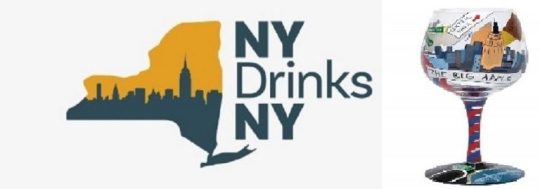
If you live in New York, work in New York or are doing business in New York – there is only one appropriate drink to order…New York State wines.
New York State of Wine
The New York grape, grape juice and wine industries generate more than $4.8 billion in economic benefits annually for New York State. There are 1,631 family vineyards, over 400 wineries, producing 175,000,000 bottles of wine, generating $408 million in state and local taxes (www.newyorkwines.org). New York’s wineries also contribute to New York State’s exports and in 2012, 19.8% of the wine produced in the state was exported.
Wineries and satellite operations attracted more than 5.9 million tourist visits in 2012, spending $401+ million. The tourism industry (including wineries, hotels, restaurants, retailing, transportation) contributes over 6400 jobs to the state, for a total of $213+ million in wages. The tourist is particularly important to the farm wineries, with sales direct to consumers representing approximately 60 percent of total wine sales volume.
The winery industry directly employs approximately 62,450 people and generates an additional 14,359 jobs in supplier and ancillary industries which supply goods and services to the industry and whose sales depend on the wine industry’s economic vitality.
In excess of 101,806 jobs can be linked to the wine industry and these positions average $51,100 in annual wages and benefits. The total wages generated by direct, indirect and induced economic activity driven by the wine industry – $5.2 billon.
New York State Wines and Wineries (Curated)

At a recent Rockefeller Center/ Rainbow Room wine event sponsored by the Wine & Grape Foundation, Sam Filler, the Executive Director of the organization stated, “New York is home to the first bonded winery in the United States, making our state one of the oldest wine regions in the country.” The objective of the NY Drinks NY Grand Tasting, “…is to showcase the diversity, artistry and accessibility of New York’s wine and food landscape.”
The 8th Annual NY Drinks NY Grand Tasting offered access to over 200 wines from approximately 50 wineries across the state.
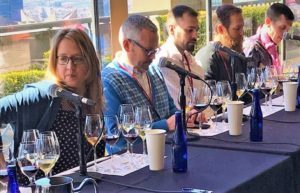
Keuka Lake Vineyard. 2017. Turkey Run. Vignoles (Finger Lakes)

Located on the slopes above the southern end of Keuka Lake this winery showcases young vinifera and old hybrid plantings that range from 3-years (representing Cabernet Franc and Vignoles), to vines over 50-years of age (representing Leon Millot and Delaware vines).
Thanks to the Finger Lakes, the vineyard produces excellent fruit. The heat of the summer is retained by the lakes and moderates the extreme cold temperatures of the vineyards in winter. As spring approaches, the frigid waters moderate the warming air temperatures and act as a delay for bud break and lower the risk of frost damage.
The terroir is a glacial mix of glacially laid rocks, sand, silt and clay that has been deposited on the lower slopes above Keuka Lake providing for water drainage that is essential for vine balance and health.

Staci Nugent
The owner is Mel Goldman and the winemaker is Staci Nugent. Nugent attended Cornell and did graduate work in California in genetics. Making a career switch, she enrolled in the wine program at the University of California at Davis, receiving a Master’s degree in Viticulture and Enology. Nugent has worked with highly regarded wineries that include Ornellaia, Italy; Hardy’s Tintara Winery, South Australia; and William Selyem, Sonoma, California. Before joining Keuka Lake Vineyards (2008), she was a winemaker at Lamoreux Landing Wine Cellars.

Sustainable farming practices brings the Vignoles to our attention. The grape is made by crossing Seible and Pinot de Corton, is associated with the Finger Lakes and grows well in the gravel soils (glacial till).
Notes: Keuka Lake Vineyards. 2017 Turkey Run Vignoles
Light bright blonde to the eye, the nose is rewarded with lemons, honey, green grapes and sweet oranges, (lemons and oranges) while the palate enjoys citrus and other fruits with the sweetness tempered by a light acidity. Pair with seafood curry, Buffalo chicken wings, pepper and Swiss cheese.
Red Newt Cellars. 2006. Legacy. Niagara Cream Sherry (Hector, New York)
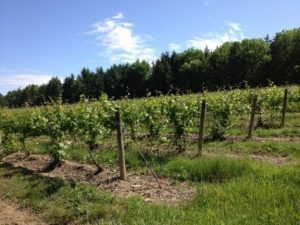
Located on the east side of Seneca Lake (Hector, NY) in the Finger Lakes region, the winery started in 1998 by David and Debra Whiting and the 1998 vintage produced 1200 cases of Chardonnay, Riesling, Vida, Cayuga, Cabernet Franc, Cabernet Sauvignon and Merlot. The first white wines were released in July 1999.
Whiting is considered to be one of the top winemakers in the Finger Lakes Region. Current production of Red Newt Cellars is apprximately 20,000 cases with a white wine focus on aromatic varities: Riesling, Gewurztraminer and Pinot Gris. CIRCLE Rielsing is the most popular and widely distributed wine, made in a classic Finger Lakes style, with hints on tangerine and honeysuckle, citrus and peach on the palate.

Kelby Russell
Kelby Russell is the head winemaker at Red Newt and considered an expert in the art of cold-climate white wines. Thanks to the variable climate of the East Coast, he recognizes that the search for the “perfect wine” is a “false idol, “ finding that the role of the winemaker is to, “…artfully direct what comes into the winery into the best thing and the most honest expression of the year that you possible can.”
At Harvard (Class of 2009) Russell majored in government and minored in economics, was a member of the Glee Club and thought his career would follow a path that would lead to orchestra management. During a study abroad experience in Tuscany he discovered the art and science of making wine.
After graduation, when a job with Jazz at Lincoln Center did not materialize, he visited Fox Run Vineyards and thought he had an interview. The staff was busy with the harvest so he was handed a shovel and offered the opportunity to help on the “crush pad.” This was the begnning of his unpaid internships and he got to spend winters in New Zealand and Australia and autumns in the Finger Lakes as an intern.
His first salaried position in 2012 was with Red Newt as an assistant winemaker. David Whiting, the co-founder and winemaker, promoted Russell to head winemaker and the rest is history. He currently directs the Red Newt house styles and reserves and develops his own Kelby James Russell label with a focus on small-batch wines, from dry rose to Australian-style dry Riesling.

Notes: Red Newt Cellars. 2006 Legacy. Niagara Cream Sherry (Niagara grapes)
The Niagara grape develops into a long-aged solera sherry, creating a complex palate experience.
Bright golden yellow to the eye (think daffodils) with the nose picking up hints of honey, raisins, oranges, apricots, yellow apples, and spices. The finish to absolutely delicious, delivering honey, lemons and spices. Perfect as a dessert course or pair with Blue cheese and pate.
Damiani Wine Cellars (DWC)
DWC was started by Lou Damiani, a Cornell engineer specializing in energy conservation, and Phil Davis. Damiani had an interest in winemaking and his education started in the field of food science before switching to engineering. In the 1990s he returned to study winemaking and mentored under Phil Hazlitt.
In 1996 Damiani wanted to plant Cabernet Franc and Merlot and visited an old friend and college friend, Phil Davis, who was also a viticulturist. They started the project and in 1997 Hazlitt pulled out a hybrid vineyard and planted Cabernet Sauvignon, Pinot Noir and Merlot. When their vineyards started producing in 2003 the next step was to make world class red wines.
Damiani was the head winemaker from 2003 – 2011 and he trained Phil Arras to continue and improve the DWC tradition. In 2007 Glenn Allen joined as a Business Consultant and later became a partner in the enterprise. Today DWC has four main vineyard sites with approximately 40 acres of land under vine and a new tasting room that hosts events and is the retail outlet.

Phil Arras, originally from Philadelphia, moved to the Finger Lakes in 2003 to attend Cornell University and majored in philosophy and political science. Inspired by a class on wine appreciation, Arrras changed his career focus to winemaking. He was hired by Damiani Wine Cellars in 2009 as the assistant winemaker and began “on the job” training. In 2012, Arras became head winemaker.
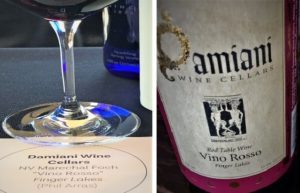
Notes: Damiani Wine Cellars. NV Marechal Foch “Vino Rosso” Finger Lakes. (Varietal may be a cross between Goldriesling and a Vitis riparia/Vitis rupestris or a cross between Gamay Noir and Vitis riparia – Oberlin 595).
Deep ruby color to the eye, an undertone of tomatoes runs alongside notes of plums and apricots and the tannins are so soft as to be obscure. Pairings might include pasta, barbeque and smoked gouda cheese.
Thirsty Owl Wine Company. 2017. Traminette
Ted Cupp purchased 150 acres of frontage on Cayuga Lake from Robert and Mary Plan, trailblazers who started the Cayuga Wine Trail in 2001. During 2001 and 2002 he began construction on the winemaking facility and tasting room for the Thirsty Owl. In 2002, in cooperation with Shawn Kime, he planted Cabernet Sauvignon, Syrah, Pinot Noir and Malbec. When the doors to the winery opened in 2002, Thirsty Owl had produced 1200 cases.

Jon Cupp, President
Today, the Thirsty Owl is synonymous with award winning wines, including the Governor’s Cup and the John Rose award for Rieslings. The Pinot Noir had the highest rated North American Pinot at the Taster’s Guild International Competition. Thirsty Owl produces Malbec and Syrah as well as blends, reds, whites and ice wine.
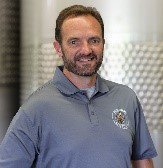
Shawn Kime
The winemaker and vineyard master, Shawn Kime, is originally from Romulus, New York and attended Morrisville College and Cornell University. Kime started to work in agriculture at the age of 14 and started winemaking after spending 2 years working with one of the earliest Finger Lake Vinifera growers.
The goal of the Thirsty Owl is to “…make changes in the vineyard and winemaking based on the year to produce wines that not only reflect our region but the growing season…. As a Finger Lakes native, I am proud of the fact that we are producing cool climate varietals that are on par with any region in the world.”
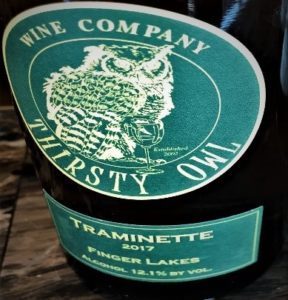
Notes: Thirsty Owl Wine Company. 2017 Traminette (cross between Gewurztraminer and Joannes Seyve 23.416).
To the eye, highlights of golden yellow. The nose finds apricots, peaches, pears, honey and fresh lemons as well as florals (especially roses and tulips) and a bit of spice. The palate is entertained with citrus and lemons, oranges and a bit of earth. The finish brings light acidity making it an interesting dessert wine.
Pair with spicy/sweet and sour sauces on chicken, pork and veal and Cheddar, Fontina and Gruyere cheese.
Benmarl Winery. 2015 Baco Noir. Hudson River Valley
Benmarl (slate hill) Winery is located in Marlboro, NY and covers 37-acres and is considered to be the oldest vineyard in America (it holds New York Farm Winery license no.1). It was owned by magazine illustrator turned vintner Mark Miller from 1957 -2003. In 2006 Victor Spaccarelli purchased the vineyard and Matthew Spaccarelli is currently the winemaker

In the 17th century, wine was being made by the French Huguenots in New Paltz, New York. Andrew Jackson Caywood started his vineyard in the early 1800s. The community was incorporated as the Village of Marlborough, a cluster of grapes carved in its seal commemorated its major crop (1788).
Caywood became an important viticulturist and leading authority in the development of new grape varieties. The Miller family bought the Caywood property in 1957 and renamed it Benmarl. It was purchased in 2006 by the Spaccarelli family. They replanted many abandoned vineyards, refurbished the estate and carry on the tradition of experimentation, planting new hybrid varieties like Traminette as well as Old World vinifera.

Notes: Benmarl Winery. 2015 Baco Noir. Hudson River Valley
The Baco Noir, made from estate-grown fruit, brings dark plum hues to the eye, and delivers the aromas of dark plums, cedar and sage to the nose. On the palate are flavors of blackberry with hints of spice. Tannins give it a structure that is delicious and the finish delivers spice and black berry fruits. Benmarl has been producing Baco Noir for 50 years. Pair with pork roast, pasta with meat sauce, beef burgers with blue cheese.
The NY Drinks NY Event
The elegant Rainbow Room @ Rockefeller Center was the venue for the New York Drinks New York event. As an important wine trade events, many hundreds of wine buyers, sellers, sommeliers, wine educators, and writers convened to experience a wine-range of quality wines produced in New York State.
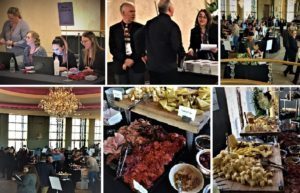
Wines of Distinction included:
Brotherhood Winery
Brotherhood Winery is the oldest continuously operating winery in America, producing wine for 180 years in Hudson Valley. It features one of the most modern bottling facilties for wine on the East coast, with a capacity of 1.5 million cases er year. A wine current featured focuses on low calories (approximately 90 calories per glass).

Glenora Wine Cellars
Glenora Wine Cellars produces award-winning Finger Lakes wines for over 40 years with a focus on sparkling wine and Riesling, sourcing grapes from 13 growers across four of the Finger Lakes. Glenora opened the first winery on Seneca Lake (1977).
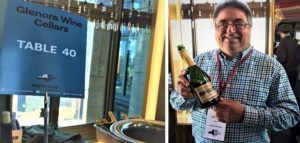
Saltbird Cellars
Robin McCarthy is the owner and winemaker at Saltbird Cellars that started in 2014 and, based on the unique maritime terroir, developed Stainless Steel Sauvignon Blanc, Migratus Barrel Fermented Sauvignon Blanc and Stainless-Steel Chardonnay.
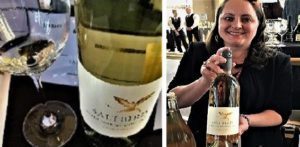
Hosmer Winery
Hosmer Winery is located on Cayuga Lake in the Finger Lakes. Grapevine plantings date back to the 1970s and early experiments with plantings of classic Vinifera started in 1985. The 70-acre estate includes Rieslings, Chardonnays, Cabernet Francs as well as French-American hybrid varieties.

For additional information: @NYWineGrapeFdn and NYWineGrapeFdn
© Dr. Elinor Garely. This copyright article, including photos, may not be reproduced without written permission from the author.
Travel News | eTurboNews
Original Article
The post Drink like a New Yorker appeared first on Tripstations.
from Tripstations http://bit.ly/2GorBpZ via IFTTT
0 notes